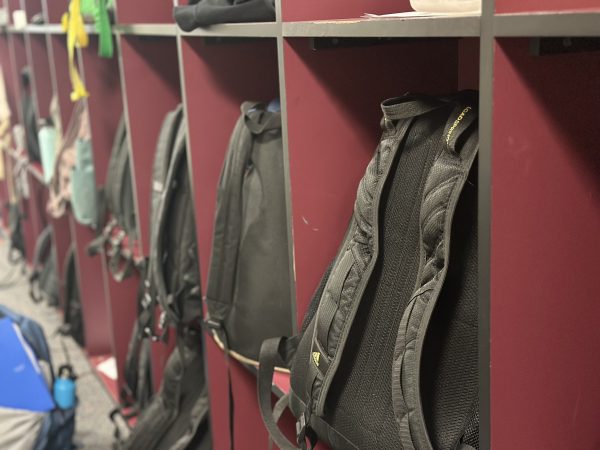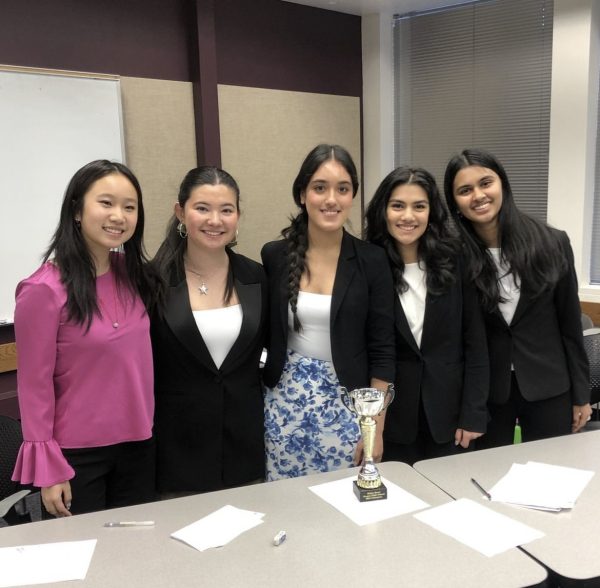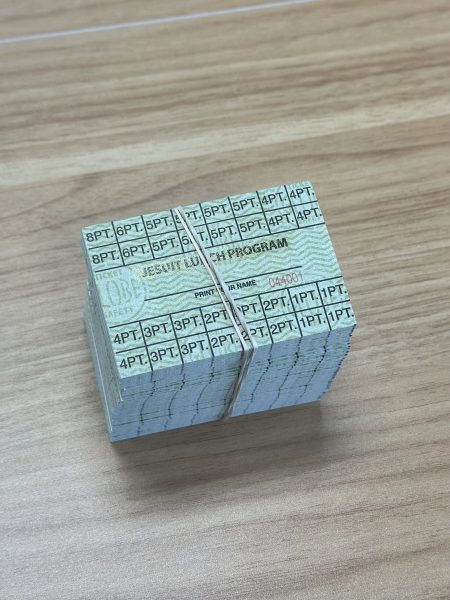Columbia Sportswear’s Director of Social Responsibility presents during Jesuit’s SJW
Mr. Peter Haney presents on the social and environmental impact of the apparel industry.
Jesuit’s third annual Social Justice Week is centered on the theme of climate change. On Tuesday, the second day of workshops, Mr. Peter Haney, the Director of Social Responsibility at Columbia Sportswear and a parent of a Jesuit alumni and current Jesuit student, presented on the social and environmental impact of the apparel industry.
The social aspect of his presentation focused on worker’s rights, highlighting the concerns of companies using cheap labor sourced from other countries to produce their products.
Before presenting this information, Haney got students involved with an interactive slideshow opportunity. Students submitted their answers to the question, “Who makes your clothes?” Their answers were then projected on the screen for everyone to see.
Common answers from students were mainly brand names–Nike, Adidas, Aritzia. Haney continued his presentation showing that really migrant workers and primarily women work in the factories that make these clothing products.
Haney explored the topics of wage disparities, unsafe working conditions, and the forced labor and exploitation these workers face. With migrant workers specifically, Haney expanded on the fact that many of them are subjected to deceptive recruiting practices. He also highlighted that they often have to rely on their employer for their housing and other basic necessities, which traps them in these unsafe working environments and does not allow them to pursue other job opportunities.
The human rights violations that take place in factories that support the fast fashion and apparel industry worldwide are atrocious. Haney challenged students to research companies’ labor and human rights’ policies and to speak out when they see brands upholding the injustices their workers face.
Haney’s work at Columbia directly focuses on addressing the social implications of product production.
“My role is just to make sure workers in our supply chain are being treated fairly and working in safe conditions. So, that involves a lot of work directly with our suppliers, going into their facilities, doing audits, doing remediation, fixing problems,” said Haney. “And it’s a bit more just about training our factories on what our expectations are, what global standards are around labor and working conditions.”
These global standards are detailed in the United Nations’ “Realization of Decent Work for All”.
Before diving into the environmental implications of the apparel industry, Haney once again projected students’ answers to another question– “What are your clothes made of?”
Some common answers on the screen included cotton and polyester.
One fact that seemed to shock some members of the audience about the material used to make their clothes is how much water goes into the process of textile and product production: Haney noted that a single T-shirt requires 700 gallons of water.
This 700 gallons is split up over the amount of water it takes to grow the cotton, wash and dye the fabric, and for other processes to produce the garment.
Haney noted that some of this water can be recycled and reused for other processes, but that the more the water is used, the harder it is to recycle.
“Every year the fashion industry uses 93 billion cubic meters of water — enough to meet the consumption needs of five million people,” according to The World Bank. “Around 20% of wastewater worldwide comes from fabric dyeing and treatment.”
As the fast fashion industry both produces and discards clothing at a rapidly increasing rate, it contributes more to the existential threat of climate change. The high amount of energy and water used to produce clothing and the unsustainable way it is used combine to create the fact that the fashion industry is responsible for 10% of global carbon emissions.
When asked why he feels it is important for students and young people to understand how their clothes are made, Haney highlighted both the environmental impact of the apparel industry as well as consumer’s purchasing power.
“Given the fact that the apparel industry is a huge contributor to CO2 emissions and environmental impact, it’s pretty critical,” said Haney. “You [as young people] are the consumers that these brands really want to get after, not because of your purchasing power today but because of your purchasing power in the future. There is some research that says that if we as brands can get you as consumers now, you’ll stay consumers as you go forward.”
Brands want to keep consumers. Haney noted that this is a goal Columbia aims for by focusing on sustainable practices and worker’s rights as a way to build trust with their consumers.
“One of our ethos of our company is to do the right thing. I think it’s super important that we take care of workers in our supply chain, just like we would take care of workers in our distribution center or our workers in our own company,” said Haney.
As many speakers highlighted throughout Social Justice Week, information about the threat of climate change can be overwhelming and taking action to combat it can be daunting. Haney, however, feels that young people can be empowered to make a difference. He offered some action items students can use in holding clothing companies accountable.
Reading clothing labels, like we do nutrition facts on the food we eat, helps consumers understand where their clothes are made and what they are made of. From there, consumers can then research brand practices, sustainability reports, which some companies update often, as well as information on global standards for labor and human rights. Consumers have the resources to evaluate the companies they buy from. Haney highlighted that “voting with your dollar”, not buying from companies with unsustainable practices is an important action students can take.
Often, more ethically made clothing can be more expensive. Investing in these pieces is not always realistic for high school students. Instead, shopping at secondhand and thrift stores is an option for those hoping to shop more sustainably.
In turn, students should also look to donate their clothing to these resale and thrift stores, rather than sending their used products to the landfill. Giving used clothing a second life is another way to address the apparel industry’s impact on the environment.
Another way to refuse to invest in unethical brand practices is to join campaigns. Haney used the example of Fashion Revolution, whose mission statement is, “We love fashion. But we don’t want our clothes to exploit people or destroy our planet.” Joining campaigns provides students with opportunities to take action, like calling or writing emails to their local representatives and attending protests.
Haney believes that the information he shared not only educates us as young people and responsible consumers but also can empower us to make change.
“I think that you’re the next group of innovators, and the next group of scientists and you’re going to figure out some of the problems I talked about – recycling and circularity,” said Haney. “This group of people are the ones who are going to figure out how to do that better, and they’re going to fix some of the problems that have come their way. They’re going to make more efficient manufacturing practices, less water use practices, and better chemistry.”















